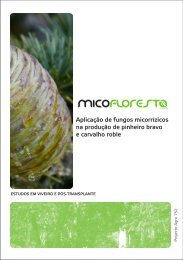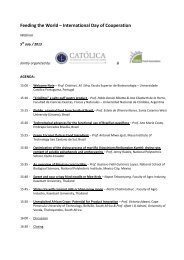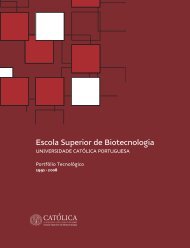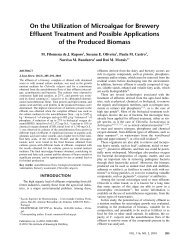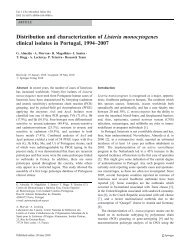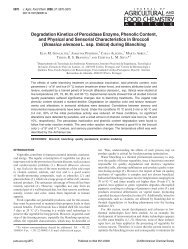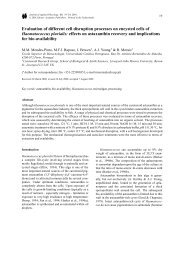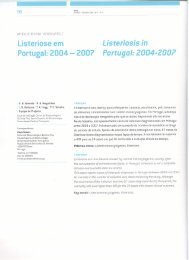Ethylene oxide sterilization of medical devices: A review
Ethylene oxide sterilization of medical devices: A review
Ethylene oxide sterilization of medical devices: A review
Create successful ePaper yourself
Turn your PDF publications into a flip-book with our unique Google optimized e-Paper software.
<strong>Ethylene</strong> <strong>oxide</strong> <strong>sterilization</strong> <strong>of</strong> <strong>medical</strong><br />
<strong>devices</strong>: A <strong>review</strong><br />
Gisela C. C. Mendes, MD, Teresa R. S. Brandão, PhD, and Cristina L. M. Silva, PhD<br />
Porto, Portugal<br />
<strong>Ethylene</strong> <strong>oxide</strong> (EO) is a well-known sterilizing agent. However, only recently has its use significantly emerged, based on its range<br />
<strong>of</strong> applications in the field <strong>of</strong> new <strong>medical</strong> device development and <strong>sterilization</strong>. This paper describes the progress in terms <strong>of</strong> EO<br />
<strong>sterilization</strong> and concludes that it remains a promising field to explore and develop. The EO action mechanism and toxicity are<br />
analyzed, and a critical analysis is made on how it is possible to use EO <strong>sterilization</strong> for <strong>medical</strong> <strong>devices</strong> advantageously, with emphasis<br />
on cycle design and validation. One huge challenge is related with the development <strong>of</strong> mathematical models to integrate<br />
lethality to allow a continuous increase <strong>of</strong> process flexibility, without compromising its safety. The scientific community should<br />
also focus on other important issues, such as EO diffusion in different substrates, taking into account different environmental conditions<br />
both for <strong>sterilization</strong> and aeration. (Am J Infect Control 2007;35:574-81.)<br />
The field <strong>of</strong> <strong>medical</strong> <strong>sterilization</strong> has become increasingly<br />
complex because <strong>of</strong> the need to prevent<br />
patient exposure to infections caused by organisms<br />
on instruments and <strong>devices</strong> used during their care.<br />
Failures in adequate <strong>sterilization</strong> <strong>of</strong> <strong>medical</strong> <strong>devices</strong><br />
(MDs) result in significant institutional costs related to<br />
patient nosocomial infections and mortality/morbidity<br />
concerns. 1,2<br />
The more widely used industrial MDs <strong>sterilization</strong><br />
technologies are steam, ethylene <strong>oxide</strong> (EO), and g<br />
and electron beam irradiation. There are other methods<br />
under development, such as low-temperature hydrogen<br />
per<strong>oxide</strong> gas plasma, low-temperature peracetic acid<br />
gas plasma, vapor-phase hydrogen per<strong>oxide</strong>, ozone,<br />
chlorine di<strong>oxide</strong>, and high-intensity visible light. 2-5<br />
EO has emerged as the <strong>sterilization</strong> method <strong>of</strong><br />
choice for MDs because <strong>of</strong> its undeniable advantages<br />
compared with other technologies, which will be discussed<br />
in more detail. EO is an exceptional sterilizing<br />
agent because <strong>of</strong> its effective bactericidal, sporicidal,<br />
and virucidal activity. However, difficulties had to be<br />
overcome, mostly related with potential hazards <strong>of</strong><br />
EO to patients, staff, and environmental, as well as<br />
risks associated with handling a flammable gas. 1,2,6-8<br />
EO has allowed and contributed significantly to the<br />
From the Universidade Católica Portuguesa, Escola Superior de Biotecnologia,<br />
Porto, Portugal.<br />
Address correspondence to Cristina L. M. Silva, PhD, Escola Superior<br />
de Biotecnologia, Rua Dr. António Bernardino de Almeida, 4200-072<br />
Porto, Portugal. E-mail: clsilva@esb.ucp.pt.<br />
Supported by Bastos Viegas, S.A., for research.<br />
0196-6553/$32.00<br />
Copyright ª 2007 by the Association for Pr<strong>of</strong>essionals in Infection<br />
Control and Epidemiology, Inc.<br />
doi:10.1016/j.ajic.2006.10.014<br />
574<br />
advancement and evolution <strong>of</strong> delicate, complex, and<br />
sophisticated MDs that otherwise would not be available<br />
because, for sensitive materials, EO is the only<br />
acceptable <strong>sterilization</strong> method. 2,6 EO <strong>sterilization</strong><br />
has become even more important since the singleuse<br />
MD market has grown, and, with the purpose <strong>of</strong><br />
cost saving in health management, there has been a<br />
transition to presentation <strong>of</strong> MDs in customized packs<br />
for use in specific <strong>medical</strong> and surgical procedures.<br />
The diversity <strong>of</strong> developed products, designs, types <strong>of</strong><br />
materials, and packaging configurations resulted in<br />
an exponential growth <strong>of</strong> EO <strong>sterilization</strong> and made<br />
this method the most widely used MD <strong>sterilization</strong><br />
technology, with a continuous growth tendency. Today,<br />
EO <strong>sterilization</strong> is described as the most cost-effective,<br />
low-temperature <strong>sterilization</strong> process available, with a<br />
recognized history <strong>of</strong> reliability. 6-11<br />
The aim <strong>of</strong> this paper is to summarize the information<br />
available on EO <strong>sterilization</strong>, and to present critical<br />
points <strong>of</strong> view about what has been done and is required,<br />
to provide the tools for advancement and optimization<br />
<strong>of</strong> EO <strong>sterilization</strong> <strong>of</strong> MDs. The present article<br />
provides a 4-part comprehensive <strong>review</strong> in the context<br />
<strong>of</strong> EO <strong>sterilization</strong> <strong>of</strong> MDs. The first part presents an<br />
overview <strong>of</strong> the EO activity mechanisms and inherent<br />
toxicity <strong>of</strong> the sterilizing agent. The second part summarizes<br />
the advantages <strong>of</strong> this <strong>sterilization</strong> technology over<br />
the other 2 industrial <strong>sterilization</strong> technologies most<br />
widely used. The objective is to explain why EO, despite<br />
many predictions about its demise as a <strong>sterilization</strong><br />
alternative, still is a dominant mode <strong>of</strong> <strong>sterilization</strong><br />
and continues to be used for increasing volumes <strong>of</strong> MDs.<br />
The third part outlines the process design and<br />
process validation procedures, including the microbiologic<br />
validation, which is the most challenging in the<br />
context <strong>of</strong> validation. Finally, the last part addresses<br />
the state-<strong>of</strong>-the-art on optimization <strong>of</strong> EO <strong>sterilization</strong>
Mendes, Brandão, and Silva November 2007 575<br />
conditions. Recently updated and very promising<br />
issues, such as parametric release, lethality, and EO<br />
diffusion modelling, are discussed.<br />
EO STERILIZATION MECHANISM AND TOXICITY<br />
EO <strong>sterilization</strong> mechanism<br />
The EO high reactivity, as expressed by the high energy<br />
<strong>of</strong> its exergonic combustion reaction, in combination<br />
with its high diffusivity, is <strong>of</strong> major importance for<br />
the inactivation <strong>of</strong> microorganisms. 12,13 EO is a direct<br />
alkylating agent that does not require metabolic activation,<br />
and its microbiologic inactivation properties are<br />
considered to be the result <strong>of</strong> its powerful alkylation<br />
reaction with cellular constituents <strong>of</strong> organisms, such<br />
as nucleic acid and functional proteins, including<br />
enzymes, which leads to consequent denaturation.<br />
The addition <strong>of</strong> alkyl groups to proteins, DNA, and<br />
RNA in microorganisms by binding to the sulfhydryl<br />
and hydroxyl, amino, and carboxyl groups, prevents<br />
normal cellular metabolism and ability to reproduce,<br />
which render affected microbes nonviable. 1,12,14-17<br />
These chemical moieties are not present in most <strong>of</strong><br />
the MDs composition; therefore, exposure to EO does<br />
not cause them similar structural changes. 5,18<br />
EO toxicity<br />
Taking into account the previously described EO<br />
<strong>sterilization</strong> action mechanism, it is easy to understand<br />
EO toxicity as a chemical agent and potential related<br />
problems with employee, patient, and environmental<br />
safety.<br />
EO toxicity in the workplace<br />
The ability <strong>of</strong> a chemical to serve as an alkylating<br />
agent, and to cause mutations in a variety <strong>of</strong> biologic<br />
test systems, is widely accepted as an indicator that<br />
the chemical may have carcinogenic potential. Both<br />
alkylation and mutagenicity potential have been demonstrated<br />
for EO. 19,20<br />
However, nowadays, EO can be used safely, with<br />
minimal personal risk <strong>of</strong> chemical hazardous exposure,<br />
by following recommended practices and<br />
meeting current Occupational Safety and Health<br />
Administration EO regulations. 9 Despite the discussions<br />
about EO potential risk, this sterilant is being<br />
used with greater frequency, especially because <strong>of</strong> investments<br />
made on equipment that have dramatically<br />
improved the efficiency <strong>of</strong> the process and make it possible<br />
to meet concerns over worker exposure. The process<br />
equipment <strong>of</strong> modern plants generally consists<br />
<strong>of</strong> tightly closed, highly automated, and controlled<br />
systems. 1,2,7,21<br />
EO toxicity in sterilized MDs:<br />
control <strong>of</strong> residues<br />
In addition to the problems associated with EO toxicity<br />
in the workplace, it is also important to take into consideration<br />
the EO and its secondary product residuals and<br />
toxicity on sterilized MDs. EO and some <strong>of</strong> its derivates,<br />
such as ethylene chlorohydrin, which appears when<br />
chloride ions are present, and ethylene glycol, formed<br />
by EO reaction with water, are toxic residues. 14,22-24<br />
Taking into consideration the diversity <strong>of</strong> MDs sterilized<br />
with EO, and the potential undesirable effect on<br />
patient health, residue control is required. The accurate<br />
determination <strong>of</strong> residues is also critical for the development<br />
<strong>of</strong> reliable risk assessment data used by<br />
toxicologists, epidemiologists, MD manufacturers, and<br />
regulatory bodies. 25<br />
The series <strong>of</strong> standards governing the biologic testing<br />
<strong>of</strong> MDs include the International Organization for<br />
Standardization (ISO) 10993-7 (Biological Evaluation<br />
<strong>of</strong> MDs—<strong>Ethylene</strong> Oxide Sterilization Residuals),<br />
which specifies the allowable limits <strong>of</strong> EO and ethylene<br />
chlorohydrin by categorization <strong>of</strong> products based on<br />
examination <strong>of</strong> toxicologic risk <strong>of</strong> the residue to the<br />
patient, according to the length <strong>of</strong> the time the patient<br />
is likely to be exposed to the device. 26<br />
Just as EO diffusivity has been a well-studied field,<br />
so, then, MD design, including the selection <strong>of</strong> materials<br />
that will follow EO <strong>sterilization</strong>, can be done in a<br />
similar logical way. Moreover, investigations about the<br />
efficacy <strong>of</strong> different aeration methods are required.<br />
Different aeration technologies have been reported,<br />
such as pulsed vacuums postprocess and heat addition,<br />
steam addition, and removal, as well as combinations<br />
<strong>of</strong> different gases and pressure set points and newer<br />
developments, such as microwave desorption. Despite<br />
the major interest on this issue, there are no recently<br />
published studies about efficiency comparisons for<br />
the different aeration technologies. 27<br />
EO STERILIZATION AND ITS SPECIFIC<br />
ADVANTAGES<br />
The compatibility <strong>of</strong> EO with a wide range <strong>of</strong> materials<br />
and its chemical molecule penetration properties<br />
in not so aggressive environments, compared with dry<br />
heat or steam, made EO <strong>sterilization</strong> the most suitable<br />
process for the majority <strong>of</strong> heat- and/or moisturesensitive<br />
<strong>medical</strong> products. 20,28<br />
The effectiveness <strong>of</strong> EO <strong>sterilization</strong>, coupled with<br />
the flexibility <strong>of</strong> the process allowed by the large number<br />
<strong>of</strong> possible control variables, represents some <strong>of</strong><br />
the advantages <strong>of</strong> this method. 1,7-10,12,18 Taking into<br />
consideration the thermal or moisture sensitivity <strong>of</strong><br />
the specific material, the parameters <strong>of</strong> the EO cycle<br />
can be adjusted to preserve the integrity <strong>of</strong> the device.
576 Vol. 35 No. 9 Mendes, Brandão, and Silva<br />
Steam and g irradiation <strong>sterilization</strong> frequently<br />
cause polymers degradation and changes in physical<br />
or mechanical properties, which can be detrimental<br />
for intended performance. 29-31 Many MDs are composed<br />
<strong>of</strong> heat-sensitive materials. Regarding g irradiation,<br />
generation <strong>of</strong> free radicals through hemolytic<br />
bond cleavage occurs because 60 Co sources supply<br />
1.17 and 1.33 MeV photon energies, which correspond<br />
to 5 orders <strong>of</strong> magnitude larger than the average energy<br />
<strong>of</strong> a chemical bond. 28,32-36<br />
The opinion <strong>of</strong> some <strong>sterilization</strong> specialists on new<br />
developments in the MDs <strong>sterilization</strong> techniques that<br />
use oxidizing agents such as hydrogen per<strong>oxide</strong>, ozone,<br />
peracetic acid, and chlorine di<strong>oxide</strong> is that limited<br />
development will occur because <strong>of</strong> inherent adverse<br />
effects on material properties. 4<br />
FROM PROCESS DESIGN TO MARKET RELEASE<br />
OF EO STERILIZED MD<br />
Process design includes the planning <strong>of</strong> the physical<br />
parameter conditions (such as temperature, humidity,<br />
and EO concentration) <strong>of</strong> a <strong>sterilization</strong> process, taking<br />
into consideration the limitations imposed by the<br />
product, the sterile barrier packaging, and the equipment.<br />
37 The efficiency and pr<strong>of</strong>itability <strong>of</strong> the process,<br />
the personnel safety, and the equipment integrity as<br />
well as the well-being <strong>of</strong> the end user <strong>of</strong> EO-sterilized<br />
MDs are all directly related to the cycle design. Regarding<br />
efficiency, the influence <strong>of</strong> each <strong>of</strong> the EO <strong>sterilization</strong><br />
process parameters on reaction kinetics should be<br />
considered when a cycle design is being conducted.<br />
Modelling <strong>of</strong> accumulated lethality and EO diffusion<br />
kinetics are 2 important issues that will be further discussed<br />
in more detail.<br />
The <strong>sterilization</strong> process must consistently assure<br />
that all critical process parameters are delivered within<br />
the load, to a degree that assures the required sterility<br />
assurance level, without causing any deleterious effect<br />
on product and its sterile barrier package functionality<br />
and safety. 37-39 These activities are part <strong>of</strong> the process<br />
validation, which includes physical and microbiologic<br />
performance qualifications.<br />
The release <strong>of</strong> the MDs to the market is done according<br />
to the process specifications defined during validation.<br />
There are 2 methodologies for market release <strong>of</strong><br />
MDs: conventional and parametric. The conventional<br />
traditional method <strong>of</strong> release requires that the process<br />
parameters are within the validated tolerance and that<br />
the biologic indicators (BIs) exposed to the <strong>sterilization</strong><br />
process are inactivated. On the other hand, parametric<br />
market release relies solely on the recording and evaluation<br />
<strong>of</strong> the process parameters because the equipment<br />
potentialities are enough to evaluate the impact<br />
<strong>of</strong> process parameters on microbiologic inactivation. 39<br />
Parametric release is still a very challenging topic and<br />
will be further discussed in more detail. A well-structured<br />
process design, its rigorous validation, and strict<br />
and efficient control <strong>of</strong> the <strong>sterilization</strong> cycle parameters<br />
are the key principles for the safe and efficacious<br />
release <strong>of</strong> the MDs to the market.<br />
Process design<br />
Investigation <strong>of</strong> all process variables impact is mandatory<br />
for reaching a well-structured EO <strong>sterilization</strong><br />
process. Furthermore, considerations about product<br />
compatibility together with optimization <strong>of</strong> the <strong>sterilization</strong><br />
process should be undertaken.<br />
The lethality <strong>of</strong> EO <strong>sterilization</strong> depends on the<br />
following 4 process parameters: (1) EO concentration,<br />
(2) exposure time, (3) temperature, and (4) humidity.<br />
1,10,37,40 The increase <strong>of</strong> EO concentration within<br />
certain limits results in extended microbial inactivation<br />
and exposure time decrease. 1,10 Heider et al 40 found a<br />
first-order kinetics behavior across the entire concentration<br />
range, from 50 to 1200 mg/L. In the past, concentrations<br />
<strong>of</strong> EO up to 1200 mg/L were common, whereas,<br />
today, EO concentrations <strong>of</strong> even less than 300 mg/L are<br />
being used. 5,40 A progressive decrease <strong>of</strong> EO concentration<br />
levels have been verified, which results in shorter<br />
aeration periods after <strong>sterilization</strong> and additional environmental,<br />
health, and safety benefits.<br />
Temperature is an extremely important parameter<br />
affecting microbial lethality. 40,41 Table 1 presents published<br />
Q10 and related z-values. A consensus seems to<br />
have involved a Q10 value <strong>of</strong> 2, which means that a<br />
108C change would affect lethality by a factor <strong>of</strong> 2.<br />
Environmental humidity appears to be another critical<br />
variable; however, there were always differing opinions<br />
about the required optimum relative humidity<br />
(RH). 13,42,43 Most <strong>of</strong> the recent studies indicate that,<br />
within the limits <strong>of</strong> 30% to 90%, the RH does not influence<br />
lethality. Sterilization efficacy decreases markedly<br />
below 30% and above 90% because RH is critical for the<br />
EO diffusivity into <strong>devices</strong> and microbes. 10,13,41 Heider<br />
et al 40 found a correlation between the reaction kinetics<br />
rate and the RH in the 10% to 60% range, whereas no<br />
further changes were observed at higher levels. According<br />
to this, it is recommended to ensure a RH <strong>of</strong> more<br />
than 60% so that the effectiveness <strong>of</strong> the <strong>sterilization</strong><br />
process is not compromised. Although, nowadays, it is<br />
considered that the RH effect is constant if the parameter<br />
is within the limits <strong>of</strong> 30% to 90%, additional studies<br />
should be further performed to assure the true veracity<br />
<strong>of</strong> this information. 10<br />
Besides the EO <strong>sterilization</strong> process parameters<br />
influence on process design, other variables, such<br />
as natural bioburden, device/package properties, load<br />
density, and configuration in which the specific MD is
Table 1. Effect <strong>of</strong> temperature on EO inactivation—Q 10<br />
and related z-values<br />
Reference Q10 z-value (8C)*<br />
Ernest 55<br />
Plug et al 56<br />
Bruch 57 and Lui 58<br />
Phillips and Miller 13<br />
*z 5 108C<br />
logQ10 .<br />
Mendes, Brandão, and Silva November 2007 577<br />
included for <strong>sterilization</strong>, should be considered. Within<br />
the device/package properties, the raw material composition,<br />
materials diffusion properties, sensitivity to<br />
both negative and positive pressure changes, and maximum<br />
allowed heat and moisture as well as chemical<br />
tolerance to EO should be analyzed. 10,40,41<br />
Process validation<br />
The validation <strong>of</strong> EO <strong>sterilization</strong> processes, which<br />
includes physical and microbiologic performance<br />
qualification, is described in detail in ISO 44 11135 and<br />
European Norm (EN) 45 550. However, none <strong>of</strong> these<br />
norms include guidance for the selection <strong>of</strong> a <strong>sterilization</strong><br />
process challenge device to be used as representative<br />
worst case matrix. Manufacturing conditions,<br />
construction materials, and product design, including<br />
materials geometric variability and packaging characteristics,<br />
are among the factors that need to be considered.<br />
However, the way to relate all these variables is<br />
a great challenge for the <strong>sterilization</strong> specialist. The<br />
physical performance qualification allows the verification<br />
<strong>of</strong> the cycle reproducibility, as well as evaluation<br />
<strong>of</strong> the cycle impact on the product, packaging functionality,<br />
and safety. 39<br />
The purpose <strong>of</strong> microbiologic validation is to assess<br />
the microbiologic lethality <strong>of</strong> the <strong>sterilization</strong> process.<br />
38,46 The above referred international and European<br />
norms provide different approaches for carrying<br />
out microbiologic performance qualification and will<br />
be described in more detail. 44,45<br />
Microbiologic validation<br />
1.8 39.2<br />
1.90 36.0<br />
2.19 29.4<br />
2.21 29.0<br />
There are 3 microbiologic approaches for process<br />
definition, which are by decreasing order <strong>of</strong> utilization:<br />
• Overkill method;<br />
• combined biologic indicator/bioburden method; and<br />
• bioburden method.<br />
The overkill approach uses BI data to assess the<br />
microbial inactivation rate for a given process. The<br />
process definition based on ‘‘Combined biological<br />
indicator (BI)/bioburden method’’ defines the treatment<br />
extent required to achieve the specified sterility<br />
assurance level from knowledge <strong>of</strong> the BIs inactivation<br />
and <strong>of</strong> the product bioburden population to be sterilized.<br />
The ‘‘Bioburden method’’ is a process definition<br />
based on inactivation <strong>of</strong> the microbial population in<br />
its natural state. 47<br />
The overkill method is applicable as long as the<br />
combination <strong>of</strong> population (10 6 microorganisms <strong>of</strong><br />
Bacillus subtilis niger, reclassified in 2001 by Fritze<br />
and Rudiger 48 as Bacillus atrophaeus) and resistance<br />
<strong>of</strong> the BI, expressed as D-value, exceeds that <strong>of</strong> the<br />
product bioburden. The <strong>sterilization</strong> process definition<br />
based on this approach is <strong>of</strong>ten conservative because<br />
necessary <strong>sterilization</strong> cycle parameters are significantly<br />
higher than those required to kill product bioburden.<br />
Cycle lethality determination can be obtained<br />
from the half-cycle method, which consists <strong>of</strong> determining<br />
the minimum time <strong>of</strong> exposure at which there<br />
are no survivors from tested BIs. According to this<br />
method, at least a 6-log reduction in population <strong>of</strong><br />
microorganisms is demonstrated for the BI organism<br />
in the half cycle. Using the same process parameters,<br />
except exposure time, full <strong>sterilization</strong> cycle achieves<br />
at least a 12-log reduction by doubling the half-cycle<br />
time. No D-value calculations are performed, and, because<br />
<strong>of</strong> its simplicity, as well to the robust sterility assurance<br />
level that is achieved, this is probably the most<br />
popular approach. 1,10,38,40,44,45,47-49 The advantage <strong>of</strong><br />
the other 2 microbiologic approaches, combined BI/<br />
bioburden method and bioburden method, is a reduction<br />
in cycle exposure time and, consequently, the product<br />
exposure to the sterilizing agent is minimized.<br />
The combined BI and bioburden method requires<br />
a low population <strong>of</strong> the product bioburden and the<br />
microorganism’s resistance to be known, as well as a<br />
high level <strong>of</strong> confidence that the bioburden data are<br />
representative <strong>of</strong> ‘‘worst case conditions.’’ The process<br />
definition based on the bioburden method requires<br />
extensive testing during the development phase and<br />
routine processing. It requires a validated bioburden<br />
recovery method and identification <strong>of</strong> the microorganisms<br />
that are typically found in or on the routine product,<br />
as well as more exigent environmental and<br />
manufacturing process control. Furthermore, it is necessary<br />
to carry out fractional exposure cycles on a regular<br />
basis to support the continued effectiveness <strong>of</strong> the<br />
<strong>sterilization</strong> process. Despite the extensive work that<br />
the bioburden method requires, it may be a requirement<br />
if there is a reason to believe that the MD may<br />
be contaminated with microorganisms more resistant<br />
than the BI. 10,38,39,47,49<br />
Besides the half-cycle method, there are 2 other<br />
commonly used methods for estimating or calculating<br />
cycle lethality: the survivor curve method and the<br />
fraction-negative method. The survivor curve construction<br />
method calculates cycle lethality based on
578 Vol. 35 No. 9 Mendes, Brandão, and Silva<br />
enumeration <strong>of</strong> survival microorganisms, and the<br />
fraction-negative method uses growth/no growth data<br />
from the sterility tests.<br />
The survivor curve construction is performed by<br />
counting microbiologic survivors in terms <strong>of</strong> colonyforming<br />
units, recovered after exposing the microbiologic<br />
population to sublethal sterilizing cycles <strong>of</strong> graded<br />
exposures <strong>of</strong> EO, with all other parameters except time<br />
remaining constant. The survivor curve construction<br />
should include at least 5 points, imposing increasing<br />
exposure times to EO, and the resulting data give the<br />
EO exposure time required to achieve a particular probability<br />
<strong>of</strong> survival <strong>of</strong> the test organism. 38,44,50<br />
The fraction-negative method is also carried out<br />
by exposing BIs to sublethal cycles, but the analysis<br />
is done to growth/no growth data from the sterility<br />
tests. 44,49,50 The exposure time required to achieve a<br />
specified survival probability <strong>of</strong> the test organism is<br />
calculated from the D-value, using the limited Spearman-Karber<br />
procedure, which is the common reference<br />
method for international standards. However,<br />
there are other commonly used statistical methods,<br />
such as the Holcomb-Spearman-Karber procedure,<br />
the Stumbo-Murphy-Cochran procedure, or the limited<br />
Stumbo-Murphy-Cochran procedure, which can be<br />
used under particular conditions, 38,50 although an<br />
ISO meeting suggested that the Stumbo-Murphy-<br />
Cochran procedure was less accurate than the limited<br />
Spearman-Karber procedure, and the ISO recommended<br />
abandoning the Stumbo-Murphy-Cochran procedure.<br />
However, according to Shintani et al, 51 the<br />
Stumbo-Murphy-Cochran procedure is not less accurate<br />
than the limited Spearman-Karber procedure. In<br />
fact, the Stumbo-Murphy-Cochran procedure seems<br />
superior to the limited Spearman-Karber procedure<br />
with the proposed restriction (ie, n $ 50, r $ 1, r/n , 0.9,<br />
where n is the number <strong>of</strong> BIs and r the number <strong>of</strong> negative<br />
BIs).<br />
Because <strong>of</strong> its major simplicity, the half-cycle<br />
method is more popular than the fraction-negative<br />
method, and the least popular is the construction <strong>of</strong><br />
the survivor curve. However, according to the present<br />
regulatory remarks, the microbiologic qualification <strong>of</strong><br />
a parametric release <strong>sterilization</strong>, which will be explained<br />
later in more detail, should not use the halfcycle<br />
method because <strong>of</strong> the fact that it does not<br />
provide sufficient information on lethality kinetics. 44<br />
EO STERILIZATION PROCESS OPTIMIZATION<br />
Optimization <strong>of</strong> EO <strong>sterilization</strong> processes is a<br />
challenge because <strong>of</strong> the fact that the global competition<br />
market requires cost-effectiveness, flexibility,<br />
and inherent reduction <strong>of</strong> overall <strong>sterilization</strong> process<br />
time while continuing to comply with regulatory<br />
requirements and product quality. 8,9,11 Traditionally,<br />
most <strong>of</strong> the EO <strong>sterilization</strong> production time is taken<br />
up with 2 operations, which are when products are<br />
held waiting for the microbiologic test results and/or<br />
for the validated aeration time to ensure residues levels<br />
in compliance with the requirements <strong>of</strong> ISO 10993-7. 26<br />
Implementation <strong>of</strong> parametric release simply eliminates<br />
the microbiologic test phase from routine. 8,9,11,44,45,52<br />
Validation <strong>of</strong> not only <strong>sterilization</strong> but also the aeration<br />
process, with consequent assessment <strong>of</strong> EO residues<br />
in compliance with the requirements <strong>of</strong> ISO<br />
10993-7, 26 has allowed a reduction in processing<br />
time. Furthermore, to get a reduction on EO residuals<br />
after <strong>sterilization</strong>, research in the field <strong>of</strong> EO diffusion<br />
is required. Investigations about comparative efficiencies<br />
among different ways <strong>of</strong> carrying aeration are<br />
also lacking. 8,9,11<br />
To shorten production time, a joint study involving<br />
<strong>sterilization</strong> and aeration processes limits shall be performed.<br />
Direct measurement <strong>of</strong> key process variables,<br />
as well as improvements in process design achieved<br />
through scientific modelling and experimental evidence,<br />
allows development <strong>of</strong> each process phase<br />
and consequent reduction in an overall <strong>sterilization</strong><br />
process time. EO <strong>sterilization</strong> process optimization<br />
will be explained below in more detail under 3 main<br />
topics: parametric release, lethality modelling, and<br />
EO diffusion modelling.<br />
Parametric market release<br />
Parametric market release is the declaration <strong>of</strong> product<br />
<strong>sterilization</strong> adequacy based solely on measurement<br />
and evaluation <strong>of</strong> physical process parameters<br />
compliant with previously validated parameters. 8,39,44,45<br />
The main difference between parametric and conventional<br />
release is the number <strong>of</strong> process parameters<br />
directly measured. According to ISO 44 11135 and<br />
EN 45 550 requirements, for conventional release<br />
compliance, the parameters that should be directly<br />
measured are the time <strong>of</strong> each phase, the pressure<br />
throughout the process, and the headspace temperature.<br />
The remaining two critical parameters, humidity<br />
and EO concentration, can be quantified indirectly<br />
by thermodynamic calculation based on pressure<br />
rise and temperature. Acceptance <strong>of</strong> the 2 indirectly<br />
measured parameters is supported by the negative<br />
growth <strong>of</strong> the exposed BIs. According to conventional<br />
release procedure, the BIs data integrate and confirm<br />
that appropriate levels <strong>of</strong> heat, water vapor, and EO<br />
concentrations have been delivered to the load, as<br />
demonstrated during microbiologic validation <strong>of</strong> the<br />
process. 11,44,45<br />
The philosophy <strong>of</strong> parametric release is that once<br />
a cycle is validated, using direct analysis <strong>of</strong> all critical
process parameters and distribution <strong>of</strong> microbiologic<br />
indicators, the resulting data can be used to define scientifically<br />
the approved physical limits <strong>of</strong> each <strong>of</strong> the<br />
process parameters. 44,45 Parametric release is, from a<br />
scientific point <strong>of</strong> view as well as from a strategic production<br />
standpoint, the preferred choice. In comparison<br />
with conventional release, the more thoroughly<br />
monitored process parameters give further understanding<br />
and stricter <strong>sterilization</strong> process control,<br />
simultaneously reducing costs and bringing a significant<br />
flexibility to the process. 8,11,44,45,52<br />
Lethality modelling<br />
The scientific modelling <strong>of</strong> the EO <strong>sterilization</strong> cycle<br />
allows the definition <strong>of</strong> optimal microbiologic inactivation<br />
conditions. The prediction <strong>of</strong> accurate D-values<br />
and process times, necessary to achieve the target<br />
sterility assurance level, allows to reduce cycle times<br />
and/or EO concentration and the comparison <strong>of</strong> effectiveness<br />
and equivalency <strong>of</strong> different <strong>sterilization</strong><br />
processes. Furthermore, the lethality modelling contributes<br />
to the process efficiency and flexibility, and<br />
the industrial movement toward parametric release is<br />
much more scientifically supported. 10,40,53<br />
To integrate mathematically the dynamic temperature<br />
and concentration conditions effects on inactivation,<br />
Rodriguez et al 42 developed the following model<br />
for BI spores <strong>of</strong> Bacillus subtilis niger:<br />
NðtÞ 5<br />
e<br />
R t<br />
kTR 0<br />
Nðt 5 0Þ<br />
CðtÞ n 10 TðtÞ2TR z dt<br />
ð1Þ<br />
where C, EO concentration; C(t), EO concentration as a<br />
function <strong>of</strong> time; k, rate constant; N, number <strong>of</strong> survivors;<br />
N(t), number <strong>of</strong> survivors as function <strong>of</strong> time;<br />
t, time; T, temperature; T(t), temperature as a function<br />
<strong>of</strong> time; T R, reference temperature; n, exponent; and z,<br />
temperature increase required to reduce the decimal<br />
reduction time (D-value) by 90%.<br />
The model was validated under the following conditions:<br />
15% to 90% RH, 200 to 1200 mg/L <strong>of</strong> EO gas, and<br />
z-value <strong>of</strong> 29, 48C. 42 The same authors also deduced<br />
an expression for determining the accumulated lethality<br />
(equivalent process time) <strong>of</strong> an EO <strong>sterilization</strong><br />
process 42 :<br />
FTR;CR;z 5 1<br />
C n R<br />
Mendes, Brandão, and Silva November 2007 579<br />
Z t<br />
0<br />
CðtÞ n 10 TðtÞ2T R<br />
z dt ð2Þ<br />
where CR, reference EO concentration; F, exposure<br />
time at TR and CR that would cause the same lethal effect<br />
as the T(t) and C(t) temperature regimes—equivalent<br />
process time.<br />
Mosley et al 10 criticized equation 2, referring that,<br />
although it is mathematically correct, it is unusable<br />
in the given format because <strong>of</strong> the fact that EO concentrations<br />
cannot be defined by any reasonable equation.<br />
Although an n 5 1 was suggested, no solution for n was<br />
proposed.<br />
Mosley et al 10 enlarged the scientific modelling <strong>of</strong><br />
EO <strong>sterilization</strong> by deducing another mathematical approach<br />
that allows the calculation <strong>of</strong> equivalent time,<br />
based on reference values for EO concentration (CR)<br />
and temperature (TR), for different EO concentration<br />
and/or temperature conditions:<br />
FCR;TR 5 10logtT R<br />
and,<br />
C<br />
CR<br />
ðT2TRÞ<br />
logtTR 5 logtT1 ð3Þ<br />
z<br />
where tT, time at a given constant temperature T; and<br />
tTR<br />
, time at reference temperature. The same investiga-<br />
tors also developed another equation to determine<br />
accumulated equivalent time, where conditions are<br />
changing for EO concentration and/or temperature:<br />
FCR;TR<br />
n<br />
5 +<br />
i 5 1<br />
n<br />
Fi 5 + 10<br />
i 5 1<br />
½logtT 1 i 1 zðTi2TRÞŠ Ci<br />
CR<br />
ð4Þ<br />
where i, process step, for which the EO concentration<br />
and temperature are constant; and n, total number <strong>of</strong><br />
process steps.<br />
According to Mosley et al, 54 greater errors can be associated<br />
with calculated integrated lethalities for steam<br />
processes because z-values are lower and more variable<br />
under steam <strong>sterilization</strong>.<br />
The mathematical models above presented are essential<br />
for designing EO <strong>sterilization</strong> processes. Optimization<br />
and validation <strong>of</strong> the different methodologies<br />
are a requirement.<br />
EO diffusion modelling<br />
The study <strong>of</strong> EO diffusion from the sterilizer headspace<br />
to the articles and through the articles is a challenge<br />
matter. Once well understood and defined,<br />
efficiency comparison among different aeration methodologies,<br />
and prediction <strong>of</strong> the dynamic distribution<br />
<strong>of</strong> EO concentration within the load, with the purpose<br />
to define the specific relationship between EO concentration<br />
and process lethality as well as to diminish EO<br />
residuals after <strong>sterilization</strong>, will be possible. However,<br />
despite the interest <strong>of</strong> this kind <strong>of</strong> studies, investigations<br />
in this field are almost inexistent. Once the modelling<br />
<strong>of</strong> accumulated lethality, as well as the modelling
580 Vol. 35 No. 9 Mendes, Brandão, and Silva<br />
<strong>of</strong> EO diffusion according to different matrices, is fully<br />
comprehended, then new approaches for design, validation,<br />
and routine control <strong>of</strong> the EO <strong>sterilization</strong><br />
processes will occur.<br />
FINAL REMARKS<br />
EO <strong>sterilization</strong> is a key issue for current <strong>medical</strong> device<br />
designs, and a considerable amount <strong>of</strong> work concerning<br />
this topic has been published. Experimental<br />
evidence and scientific modelling have allowed significant<br />
improvements on each process phase, resulting<br />
in overall reduction <strong>of</strong> <strong>sterilization</strong> process time, without<br />
compromising the delivery <strong>of</strong> sterile and safe products<br />
to the market.<br />
Further developments are needed in terms <strong>of</strong> understanding<br />
the microbiologic inactivation kinetics under<br />
EO <strong>sterilization</strong> process conditions. In parallel, there<br />
is much to be done to understand EO diffusion behavior<br />
on different materials. The ability to predict the dynamic<br />
distribution <strong>of</strong> EO concentration within the load<br />
being sterilized would allow the estimation <strong>of</strong> theoretical<br />
sterilizing EO concentrations.<br />
Comparison <strong>of</strong> effectiveness and equivalency <strong>of</strong> different<br />
aeration methodologies are also required. In the<br />
same context, it is also critical that the development <strong>of</strong><br />
reliable risk-assessment analysis for EO and related<br />
residuals mature.<br />
In terms <strong>of</strong> speed to the market and despite the<br />
great advances already achieved, EO <strong>sterilization</strong><br />
and its unique capabilities are still in progress. Regarding<br />
newer and future developments on MD <strong>sterilization</strong><br />
methodologies, it is essential to compare<br />
them against the characteristics <strong>of</strong> an ideal lowtemperature<br />
(,608C) sterilant, which includes high<br />
efficacy, rapid activity, strong penetrability, material<br />
compatibility, nontoxicity, adaptability, ability to withstand<br />
an organic load, monitoring capability, and costeffectiveness.<br />
References<br />
1. Rutala WA, Weber DJ. Infection control: the role <strong>of</strong> disinfection and<br />
<strong>sterilization</strong>. J Hosp Infect 1999;43(Suppl):S43-55.<br />
2. Anonymous. The future <strong>of</strong> low-temperature <strong>sterilization</strong> technology—<br />
safety, economics and the environment. Pamphlet, Newport Beach,<br />
CA: Communicore; 1996.<br />
3. Rutala WA, Gergen MF, Weber DJ. Comparative evaluation <strong>of</strong> the<br />
sporicidal activity <strong>of</strong> new low-temperature <strong>sterilization</strong> technologies:<br />
ethylene <strong>oxide</strong>, 2 plasma <strong>sterilization</strong> systems, and liquid peracetic<br />
acid. Am J Infect Control 1998;26:393-8.<br />
4. Feldman LA, Hui HK. Compatibility <strong>of</strong> <strong>medical</strong> <strong>devices</strong> and materials<br />
with low-temperature hydrogen per<strong>oxide</strong> gas plasma. Medical Device<br />
and Diagnostic Industry Magazine December 1997.<br />
5. Fairand BP, Gillis JR, Mosley GA, Mowitt S. Industrial <strong>sterilization</strong> for<br />
<strong>medical</strong> <strong>devices</strong>. Washington, DC: Association for the Advancement<br />
<strong>of</strong> Medical Instrumentation; October 2003.<br />
6. Barker J. <strong>Ethylene</strong> <strong>oxide</strong> <strong>sterilization</strong> update. Med Device Technol<br />
1995;6:23-4.<br />
7. Hucker G, Axel K. Validation <strong>of</strong> ethylene <strong>oxide</strong>-<strong>sterilization</strong> using a<br />
new measuring system. Biomedizinische Technik 2001;46:150-3.<br />
8. Strain P, Young WT. <strong>Ethylene</strong>-<strong>oxide</strong> <strong>sterilization</strong> aids speed to<br />
market—process developments reduce process times. Med Device<br />
Technol 2004;15:18-9.<br />
9. Strain P, Young B. Methods to reduce <strong>sterilization</strong> process time.<br />
Med Design Technol December 2004;17-8.<br />
10. Mosley GA, Gillis JR, Whitbourne JE. Calculating equivalent time for<br />
use in determining the lethality <strong>of</strong> EtO <strong>sterilization</strong> processes. Medical<br />
Device and Diagnostic Industry Magazine February 2002.<br />
11. Sordellini PJ, Bonanni FR, Fontana GA. Optimizing EtO <strong>sterilization</strong>.<br />
Medical Device and Diagnostic Industry Magazine August 2001.<br />
12. Bommer J, Ritz E. <strong>Ethylene</strong> <strong>oxide</strong> (ETO) as a major cause <strong>of</strong> anaphylactoid<br />
reactions in dialysis [<strong>review</strong>] Artif Organs 1987;11:111-7.<br />
13. Phillips GB, Miller WS. Industrial <strong>sterilization</strong>. Durham, NC: Becton<br />
Dickinson Company and Duke University Press; 1973. p. 239-82.<br />
14. Poothulil J, Shimizu A, Day RP, Dolovich J. Anaphylaxis from the product(s)<br />
<strong>of</strong> ethylene <strong>oxide</strong> gas. Ann Intern Med 1975;82:58-60.<br />
15. Grammer LC, Shaughnessy MA, Paterson BF, Patterson R. Characterization<br />
<strong>of</strong> an antigen in acute anaphylactic dialysis reaction: <strong>Ethylene</strong><br />
<strong>oxide</strong>-altered human serum albumin. J Allergy Clin Immunol 1985;<br />
76:670-5.<br />
16. Swenberg JA, Ham A, Koc H, Morinello E, Ranasinghe A, Tretyakova<br />
N, Upton PB, Wu Kuen-Yuh. DNA adducts: effects <strong>of</strong> low exposure<br />
to ethylene <strong>oxide</strong>, vinyl chloride and butadiene. Mutat Res 2000;<br />
464:77-86.<br />
17. D’Ambrosio FP, Savica V, Gangemi S, Ricciardi L, Bagnato GF, Santoro<br />
D, Cuzzocrea S, Bellinghieri G. <strong>Ethylene</strong> <strong>oxide</strong> allergy in dialysis<br />
patients. Nephrol Dial Transplant 1997;12:1461-3.<br />
18. Festa RM. <strong>Ethylene</strong> <strong>oxide</strong>: The way we choose to go. Available at:<br />
http://www.infectioncontroltoday.com/articles/131bpract.html. Accessed<br />
February 26, 2007.<br />
19. NIOSH Current Intelligence Bulletin 35. <strong>Ethylene</strong> Oxide (EtO). DHHS<br />
(NIH) Publication No. 81-130. Cincinnati, OH: Department <strong>of</strong> Health<br />
and Human Services; 1981. p. 22.<br />
20. Angerer J, Bader M, Kramer A. Ambient and biochemical effect monitoring<br />
<strong>of</strong> workers exposed to ethylene <strong>oxide</strong>. Int Arch Occup Environ<br />
Health 1998;71:14-8.<br />
21. NOHSC: 3016. Guidance note for safe use <strong>of</strong> ethylene <strong>oxide</strong> in sterilisation/fumigation<br />
processes; 1992.<br />
22. International Programme on Chemical Safety: environmental health<br />
criteria for ethylene <strong>oxide</strong>. World Health Organization: Geneva; 1985<br />
23. Furuhashi M, Miyamae T. <strong>Ethylene</strong> <strong>oxide</strong> <strong>sterilization</strong> <strong>of</strong> <strong>medical</strong><br />
<strong>devices</strong>—with special reference to the sporicidal activity and residual<br />
concentration <strong>of</strong> ethylene <strong>oxide</strong> and its secondary products. Bull<br />
Tokyo Med Dent Univ 1982;29:23-35.<br />
24. Buben I, Melichercíková V, Novotná N, Svitáková R. Problems associated<br />
with <strong>sterilization</strong> using ethylene <strong>oxide</strong>: residues in treated materials.<br />
Cent Eur J Public Health 1999;4:197-202.<br />
25. Centola DT, Ayoub KI, Lao NT, Lu HTC, Page BFJ. Variables affecting<br />
simulated use determination <strong>of</strong> residual ethylene <strong>oxide</strong> in <strong>medical</strong><br />
<strong>devices</strong>. J AOAC Int 2001;84:512-8.<br />
26. ISO 10993-7. Biological evaluation <strong>of</strong> <strong>medical</strong> <strong>devices</strong>. Part 7: ethylene<br />
<strong>oxide</strong> <strong>sterilization</strong> residuals. Porto, Portugal: International Standard<br />
Norm; 1995.<br />
27. Peacock R. <strong>Ethylene</strong> <strong>oxide</strong> <strong>sterilization</strong>: the way ahead. Med Device<br />
Technol 1999;10:24-6.<br />
28. Baier RE, Meyer AE, Akers CK, Netielle JR, Maanaghan M, Carter JM.<br />
Degradative effects <strong>of</strong> conventional steam <strong>sterilization</strong> on biomaterial<br />
surfaces. Biomaterials 1982;3:241-5.<br />
29. The effect <strong>of</strong> <strong>sterilization</strong> methods on plastic and elastomers. New<br />
York: Plastic Design Library Handbook Series; 1996.<br />
30. Gorna K, Gogolewski S. The effect <strong>of</strong> g radiation on molecular<br />
stability and mechanical properties <strong>of</strong> biodegradable polyurethanes<br />
for <strong>medical</strong> applications. Polymer Degradation Stability 2003;79:<br />
465-74.
Mendes, Brandão, and Silva November 2007 581<br />
31. Fray ME, Bartkowiak A, Prowans P, Slonecki J. Physical and mechanical<br />
behaviour <strong>of</strong> electron-beam irradiated and ethylene <strong>oxide</strong> sterilized<br />
multiblock polyester. J Materials Sci: Materials Med 2000;11:757-62.<br />
32. Affatato S, Bordini B, Fagnano C, Taddei P, Tinti A, Toni A. Effects <strong>of</strong><br />
the sterilisation method on the wear <strong>of</strong> UHMWPE acetabular cups<br />
tested in a hip joint simulator. Biomaterials 2002;23:1439-46.<br />
33. Goldman M, Gronsky R. The effects <strong>of</strong> g radiation <strong>sterilization</strong> and<br />
ageing on the structure and morphology <strong>of</strong> <strong>medical</strong> grade ultra high<br />
molecular weight polyethylene. Polymer Degradation Stability 1996;<br />
37:2909-13.<br />
34. Ries MD, Weaver K, Rose RM, Gunther J, Sauer W, Beals N. Fatigue<br />
strength <strong>of</strong> polyethylene after <strong>sterilization</strong> by gamma irradiation or<br />
ethylene <strong>oxide</strong>. Clin Orthop 1996;333:87-95.<br />
35. Kurtz SM, Muratoglu OK, Evans M, Edidin AA. Advances in the<br />
processing <strong>sterilization</strong>, and cross-linking <strong>of</strong> ultra-high molecular<br />
weight polyethylene for total joint arthroplasty. Biomaterials 1999;<br />
20:1659-88.<br />
36. Costa L, Jacobson K, Bracco P. Brach del Prever EM. Oxidation <strong>of</strong><br />
orthopaedic UHMWPE. Biomaterials 2002;23:1613-24.<br />
37. Sordellini PJ, Satter SE, Caputo VA. EtO <strong>sterilization</strong>: principles <strong>of</strong><br />
process design. Medical Device and Diagnostic Industry Magazine<br />
December 1998.<br />
38. ISO/FDIS 14161. Sterilization <strong>of</strong> health care products—biological indicators—guidance<br />
for the selection, use and interpretation <strong>of</strong> results.<br />
International Standard Norm; 2000.<br />
39. AAMI TIR 20. Parametric release for EO <strong>sterilization</strong>. Association for<br />
the Advancement <strong>of</strong> Medical Instrumentation Standard; 2001.<br />
40. Heider D, Gomann J, Junghann BU, Kaiser U. Kill kinetics study <strong>of</strong><br />
Bacillus subtilis spores in ethylene <strong>oxide</strong> sterilisation processes. Zentr<br />
Steril 2002;10:158-67.<br />
41. Mosley GA, Gillis JR, Whitbourne JE. Formulae for calculations <strong>of</strong><br />
integrated lethality for EtO <strong>sterilization</strong> processes. Pharm Technol<br />
2002; October:1-12.<br />
42. Rodriguez AC, Young B, Caulk K, Zelewski J, Kwasnica S, Aguirre S.<br />
Calculating accumulated lethality and survivorship in EtO sterilisation<br />
processes. Medical Device and Diagnostic Industry Magazine September<br />
2001.<br />
43. Oxborrow GS, Placencia AM, Danielson JW. Effects <strong>of</strong> temperature<br />
and relative humidity on biological indicators used for ethylene <strong>oxide</strong><br />
<strong>sterilization</strong>. Appl Environ Microbiol 1983;45:546-9.<br />
44. ISO 11135. Medical <strong>devices</strong>—validation and routine control <strong>of</strong> ethylene<br />
<strong>oxide</strong> <strong>sterilization</strong>. International Standard Norm; 1994.<br />
45. EN 550. Sterilization <strong>of</strong> <strong>medical</strong> <strong>devices</strong>—validation and routine control<br />
<strong>of</strong> ethylene <strong>oxide</strong> <strong>sterilization</strong>. European Norm; 1994.<br />
46. Mosley GA, Houghtling CW. Interpreting and understanding microbial<br />
data in validation <strong>of</strong> ethylene <strong>oxide</strong> <strong>sterilization</strong> processes. Biomed<br />
Instrum Technol 2005;39:466-82.<br />
47. ANSI/AAMI/ISO 14937. Sterilization <strong>of</strong> health care products—general<br />
requirements for characterization <strong>of</strong> a sterilizing agent and the development,<br />
validation, and routine control <strong>of</strong> a <strong>sterilization</strong> process for<br />
<strong>medical</strong> <strong>devices</strong>. Association for the Advancement <strong>of</strong> Medical Instrumentation<br />
Standard; 2000.<br />
48. Fritze D, Rudiger P. Reclassification <strong>of</strong> bioindicator strains Bacillus<br />
subtilis DSM 675 and Bacillus subtilis DSM 2277 as Bacillus atropaeus.<br />
Int J Syst Evol Microbiol 2001;51:35-7.<br />
49. AAMI TIR 16. Process development and performance qualification for<br />
ethylene <strong>oxide</strong> <strong>sterilization</strong>—microbiological aspects. Association for<br />
the Advancement <strong>of</strong> Medical Instrumentation Standard; 2000.<br />
50. ISO 11138-1. Sterilization <strong>of</strong> health care products—biological indicators.<br />
Part 1: general requirements. International Standard Norm; 2006.<br />
51. Sintani H, Tahata T, Hatakeyama K, Takahashi M, Ishii K, Hayashi H.<br />
Comparison <strong>of</strong> the D10-value accuracy by the Limited Spearman-<br />
Karber Procedure (LSKP), the Stumbo-Murphy-Cochran Procedure<br />
(SMCP), and the Survival-Curve Method (EN). Biomed Instrum Technol<br />
1995;29:113-25.<br />
52. Allen D. Managing <strong>sterilization</strong> costs. Savings could lie in five key areas.<br />
Pharmaceutical and Medical Packaging News April 2002.<br />
53. Brinston RM. The economics <strong>of</strong> <strong>sterilization</strong>. Med Device Technol<br />
1995;6:6-22.<br />
54. Mosley GA, Gillis JR, Krushefski G. Evaluating the formulae for integrated<br />
lethality in ethylene <strong>oxide</strong> <strong>sterilization</strong> using six different endospores<br />
forming strains <strong>of</strong> bacteria, and comparisons <strong>of</strong> integrated<br />
lethality for ethylene <strong>oxide</strong> and steam systems. PDA J Pharm Sci Technol<br />
2005;59:64-86.<br />
55. Ernest RR. <strong>Ethylene</strong> Oxide gaseous <strong>sterilization</strong> for industrial applications.<br />
Industrial Sterilization, International Symposium, Amsterdam,<br />
1972. In: Phillips GB, Miller WS, editors. Durham, NC: Duke<br />
University Press; 1973. p. 181-208.<br />
56. Plug IJ, Holcomb RG, Gomez MM. Thermal destruction <strong>of</strong> microorganisms.<br />
In: Block S, editor. Disinfection, <strong>sterilization</strong>, and preservation.<br />
Philadelphia: Lippincott, Williams & Wilkins; 2001. p. 79-129.<br />
57. Bruch CW. <strong>Ethylene</strong> Oxide <strong>sterilization</strong>—technology and regulation.<br />
Industial ethylene <strong>oxide</strong> <strong>sterilization</strong> <strong>of</strong> <strong>medical</strong> <strong>devices</strong>: process design,<br />
validation, routine <strong>sterilization</strong>, AAMI Technological Assessment<br />
Report No. 1-81. Arlington, VA: Association for the Advancement <strong>of</strong><br />
Medical Instrumentation; 1981. p. 3-5.<br />
58. Lui TS. Dichlorodifluoromethane—ethylene <strong>oxide</strong> <strong>sterilization</strong> as a<br />
sterilant at elevated temperatures. Food Technol 1968;22:86-9.




